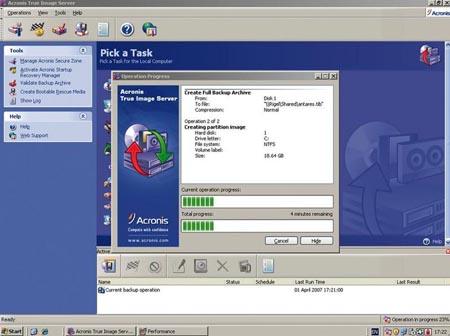- July 29, 2007
- Posted by: Đào Nhật Minh
- Category: Technology news
Acronis True Image provides a simple but effective disaster-recovery system, with useful data backup facilities.
Backup software is essential in any sysadmin’s toolkit. Without frequent and reliable backups, a system failure can be a disaster for the organization and perhaps for its clients. Even with accurate backups, it can be a long time before a system can be restored to full working order, and this is where disaster-recovery software comes into its own. Facilities to make a complete image of a working installation and restore it to a “bare-metal” system can save time that would otherwise be spent installing, patching and configuring operating systems and applications, and restoring data from backup.
System image files can be created on remote systems across a network, either LAN or WAN, or to local devices such as DVD or CD burners, or other disk drives. Individual files and disk partitions can be backed up and restored in the same way. Acronis True Image offers the option to back up a system to itself too, storing images in a designated Acronis Secure Zone on a local drive. This is simply a hidden partition that can be accessed only by Acronis True Image. Acronis True Image Recovery Manager can restore a system from this data with a single keystroke. This is handy for users operating in remote locations with limited internet access, since the user can recover a damaged system without returning to base for technical support.
Some system-imaging software requires exclusive use of the system during the process. Acronis True Image can run alongside other apps, even when copying critical system files. Its support for Microsoft’s Volume Shadow Copy Service also allows it to back up data for Exchange or SQL Server while they’re still running, so day-to-day operations aren’t affected.
Acronis True Image 9.1 Server for Windows isn’t restricted to making exact images. It can also operate as a normal backup system, offering similar differential and incremental backup options to those found in tape-orientated systems such as Symantec’s Backup Exec for Windows Servers 11d (see issue 150, p156). Files can be excluded from being backed up, so backup times can be reduced by ignoring easily replaced data. Acronis supports FAT16, FAT32 and NTFS file systems. In a network environment, the software provides facilities to notify designated users by email and Windows Messenger. Notifications can be sent according to the result of any operation, successful or otherwise. Users can also be warned when a user action is required, and the software’s event log can be appended as well. The system provides job-scheduling options, and when these are combined with the user-notification features it’s possible to operate an automatic backup and system-imaging arrangement.
Performance was impressive. We installed the software on a Windows Server 2003 system with two IntelXeon 28GHz processors and 2GB of RAM using a single hard disk attached to a parallel ATA interface. This system also hosted an active SQL Serverdatabase. We then backed up the system to another Windows Server 2003, transferring 2.33GB in 4mins 30secs, giving a transfer rate of 8.4MB/sec using Gigabit Ethernet connections. Acronis True Image’s combination of file archiving and disk imaging makes it an attractive solution to both system and data-recovery issues.
(Source – PC Pro July, 2007)

